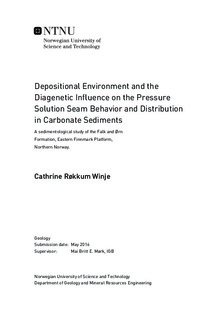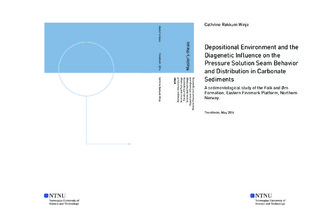| dc.description.abstract | Pressure solution seams and porosity have been investigated in carbonate sediments of the Falk and Ørn Formation in core 7030/03-U-01 offshore northern Norway on the eastern part of the Finnmark Platform. A detailed sedimentological log of the core was made based on core and thin sections, which included 10 sedimentary facies, hence 7 carbonate facies. Based on their vertical arrangement, 8 different facies sections were defined and were interpreted to represent different placements on a distal to proximal cross section of a carbonate ramp.
The recorded pressure solution seams were divided into two groups based on their mean amplitude value, where 1) dissolution seams include mean amplitude values lower than 1 mm, and 2) stylolites are defined when amplitudes are higher than 1 mm. The pressure solution seams within both classes were categorized by low or high amplitude, nodule-bounding and if several occur together in swarms. Additionally the stylolite s mean amplitude value and style have been registered. Due to the depositional environment and facies composition, the muddy facies (mudstone and wackestone) is shown to favor dissolution seams, and the Palaeoaplysina/phylloid algae boundstone stylolites. The formation of dissolution seams require a significant amount of clay present and has taken place under several circumstances, and is therefore common in the core, whereas stylolites require minor clay and seems to rely on the presence of early calcite cementation for developing. Formation of both types of seams is generally inhibited by a host rock comprising dolomite, though if they form, dissolution seams are most common. Despite different appearance of the dissolution seams and stylolites, the amount of clay and the host rock composition, including obstacles and restrictions, are the main controlling factors. Diagenetic processes associated with the seams development include both cementation and dolomitization.
A porosity classification was done for each facies, and intercrystalline porosity is the most widespread. It has developed in relation to dolomitization of Palaeoaplysina/phylloid algae boundstone and mudstone. These lithologies have porosity values that make good candidates for reservoirs, with highest values obtained in the dolomitized mudstone. The dolomitization is interpreted to have formed already in the depositional environment in shallow subtidal and intertidal environment. Dolomitization and intercrystalline porosity seem to be spatially related to the seams, with very local appearance. Beyond this, much of the core shows tight porosity. Within the Palaeoaplysina/phylloid algae boundstone tight porosity is associated with abundant stylolites and associated cement. Tight porosity in the mudstone, in part reflect early calcite cementation and mechanical compaction. Porosity types such as interparticle, moldic and microporosity are also proven in the core, though their presence have only minor effects on the total properties. | |

